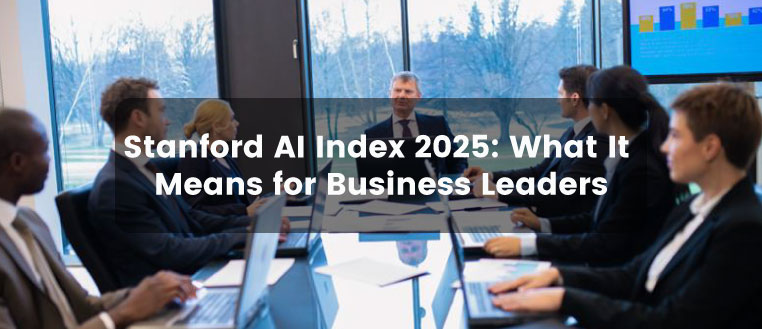The latest Stanford AI Index Report reinforces a decisive shift in global business strategy: AI has moved from experimentation to essential infrastructure. Once treated as a future-ready initiative, AI is now a core driver of competitiveness, efficiency, and operational transformation.
The report highlights accelerating enterprise adoption, rapidly evolving model performance, and a global surge in AI investment and policy attention. This confirms what leading organizations already understand — AI is becoming the defining technology of the 21st century.
As this shift accelerates, organizations that invest early in AI capability, governance, and workforce readiness will hold a lasting advantage, while reactive approaches will increasingly limit competitiveness.
In the sections ahead, we break down key insights from the Stanford AI Index Report — starting with the undeniable rise in enterprise AI adoption and what it means for business leaders.
Key Trends from the Stanford 2025 AI Index Report
1). AI Adoption Has Crossed the Point of No Return
According to the Stanford AI Index, enterprise AI usage grew sharply from 55% to 78% over the past year, marking a shift from experimentation to mainstream deployment.
Private capital investment in AI also hit record levels, signaling strong confidence in AI’s long-term business value. At the same time, smaller and more efficient models are reducing compute requirements and making AI adoption more accessible across industries.
The data shows a clear inflection point: AI is now fundamental to modern operations, not optional innovation.
2). AI Capability & Performance Are Exploding
The Stanford AI Index reports substantial capability gains across advanced benchmarks in reasoning, coding, and complex task execution.
In controlled programming environments, AI systems surpassed human performance under time constraints, indicating strengthened reliability in technical problem-solving.
At the same time, breakthroughs in multimodal models are enabling high-quality video and sophisticated content generation, reducing reliance on specialized creative resources.
These improvements signal a shift from AI assisting workflows to AI directly executing high-value, knowledge-driven tasks at scale.
3). The Global AI Power Race
AI has become a driver of geopolitical influence and economic strategy. While the U.S. currently leads in frontier model development, China is closing the performance gap and continues to generate the most AI research and patents worldwide.
Meanwhile, emerging innovation centers across India, the Middle East, and other regions are accelerating AI funding and infrastructure, signaling a shift toward a more distributed global AI ecosystem.
This evolving landscape will shape where companies source talent, form technology partnerships, and build future research and operational hubs.
4). AI Is Becoming Faster, Cheaper, & Mass-Accessible
The Stanford AI Index Report notes a clear shift: AI efficiency is accelerating as compute costs decline, compact models improve, and open-weight systems narrow the performance gap with proprietary giants.
This trend signals a structural transition in AI economics — shifting the technology from elite research labs into mainstream commercial deployment, enabling far wider participation in the AI economy.
5). Productivity & Workforce Transformation Accelerate
The Stanford AI Index Report highlights that AI is materially improving workforce productivity, reducing skill gaps, and driving higher adoption across industries.
Rather than replacing work outright, the data suggests a shift toward augmented roles — where human expertise and AI systems operate in tandem.
This marks a transition from isolated AI experimentation to organizational-wide enablement, where capability building, talent strategy, and operational redesign become central to competitiveness.
6). Responsible AI: Policy Growth Outpaces Enterprise Practice
The Stanford AI Index Report notes a clear rise in documented AI incidents alongside a rapid expansion of government-level regulatory frameworks.
However, corporate implementation continues to lag behind policymaking momentum, widening the execution gap.
This shift signals an era where responsible AI is transitioning from optional governance to mandated compliance, and organizations must move from aspirational principles to enforceable systems and controls.
7). Governments Are Accelerating AI Investment at Scale
According to the Stanford AI Index Report, governments worldwide are escalating AI commitments through substantial public funding programs.
Major economies, including the U.S., EU, China, India, and Saudi Arabia, have positioned AI as a strategic national priority.
This intensifying policy-driven competition underscores AI’s role in shaping global economic strength and future industrial leadership.
8). AI Progress Is Real — But Critical Limitations Remain
While AI systems continue advancing rapidly, the Stanford AI Index emphasizes that meaningful constraints persist.
Complex reasoning remains inconsistent, models still generate errors, and reliability challenges appear. Especially in high-stakes environments such as healthcare, finance, and public governance.
These limitations reinforce a clear message: AI is transformational, but not yet autonomous — maintaining informed human oversight is essential.
What Businesses Must Do Now
- Establish internal AI strategy and governance frameworks
- Upskill teams on AI usage, risks, and responsible deployment
- Experiment with both foundation models and efficient small models
- Prioritize AI use cases that deliver measurable productivity improvements today
Conclusion: Turning Insight Into Action
AI’s momentum is undeniable — from accelerating adoption and rising capability benchmarks to expanding global investment and policy frameworks.
The trajectory is clear: organizations that build disciplined, well-governed AI strategies today will lead markets tomorrow.
At NexaQuanta, we support enterprises in moving from awareness to execution — responsibly and securely.
Our focus is on enabling organizations to adopt AI with clear governance, scalable implementation models, workforce readiness, and measurable business outcomes.
As AI becomes a foundational layer of modern business, the priority is not just to adopt it — but to adopt it intelligently, ethically, and with long-term value in mind.

